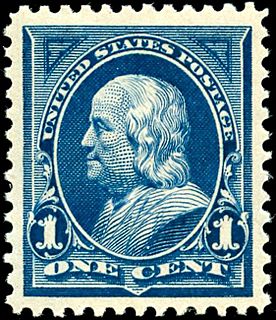
Stamp collecting is the collecting of postage stamps and related objects. It is related to philately, which is the study of stamps. It has been one of the world's most popular hobbies since the late nineteenth century with the rapid growth of the postal service, as a never-ending stream of new stamps was produced by countries that sought to advertise their distinctiveness through their stamps.

A cancellation is a postal marking applied on a postage stamp or postal stationery to deface the stamp and prevent its re-use. Cancellations come in a huge variety of designs, shapes, sizes and colors. Modern cancellations commonly include the date and post office location where the stamps were mailed, in addition to lines or bars designed to cover the stamp itself. The term "postal marking" sometimes is used to refer specifically to the part that contains the date and posting location, although the term often is used interchangeably with "cancellation." The portion of a cancellation that is designed to deface the stamp and does not contain writing is also called the "obliteration" or killer. Some stamps are issued pre-cancelled with a printed or stamped cancellation and do not need to have a cancellation added. Cancellations can affect the value of stamps to collectors, positively or negatively. The cancellations of some countries have been extensively studied by philatelists and many stamp collectors and postal history collectors collect cancellations in addition to the stamps themselves.

Philatelic literature is written material relating to philately, primarily information about postage stamps and postal history.

The 2¢ Large Queen on laid paper is the rarest postage stamp of Canada. Printed in 1868, it was not discovered until 1925, and so far only three have been found, all used. Many more could exist as at least one sheet must have been printed, and possibly many sheets; however, they may all have been destroyed, or lie unrecognised in stamp collections or on cover.
Alfred F. Lichtenstein was one of the most famous American philatelists.

The Hawaiian Missionaries are the first postage stamps of the Kingdom of Hawaii, issued in 1851. They came to be known as the "Missionaries" because they were primarily found on the correspondence of missionaries working in the Hawaiian Islands. Only a handful of these stamps have survived to the present day, and so they are amongst the great rarities of philately.

In general, philatelic fakes and forgeries refers to labels that look like postage stamps but are not. Most have been produced to deceive or defraud. Learning to identify these can be a challenging branch of philately.
Harrison Donald Seaman Haverbeck or H.D.S. Haverbeck, FRPSL, RDP, was a noted philatelist and philatelic journalist, whose interests centered on India and Indian states, Tibet and Nepal.
The Ruch catalog of postage stamps of Poland, officially titled Ilustrowany Katalog Znaczków Polskich, contains detailed information on Polish postage stamps, and was published on a yearly basis.
John Robert Boker Jr., of New York City, was a philatelist who amassed some of the most prestigious collections of 19th century stamps ever seen by stamp collectors. Before his death in 2003, the Collectors Club of New York declared him, in 1996, to be the "outstanding philatelist of the last half of the twentieth century."
Herbert J. Bloch, who emigrated from Europe to New York City in 1936, was a philatelist and stamp dealer who became recognized as a leading expert on authentication of rare European postage stamps.
Mortimer L. Neinken of New York City, was a collector and student of classic United States postage stamps. He studied with Stanley Bryan Ashbrook, and extended some of the philatelic literature work of Ashbrook.
William Hubert Miller Jr., of New York City, was an aerophilatelist who published philatelic literature on the subject.
James H. Beal, of Ohio, was a philatelist who was a recognized expert on fakes and forgeries of rare postage stamps.
Woodrow Wilson Hulme II was a philatelist noted for his work in advancing the appreciation of stamp collecting, especially by his work at the National Postal Museum in Washington, D.C.
Charles Foster Richards, of New York City, was a lifelong stamp collector and a charter member of the American Philatelic Association.
The Confederate Stamp Alliance is a philatelic organization dedicated to the collection and study of postage stamps and postal history of the Confederate States of America (CSA). It is an affiliate of the American Philatelic Society.

Philatelic expertisation is the process whereby an authority is asked to give an opinion whether a philatelic item is genuine and whether it has been repaired or altered in any way.









